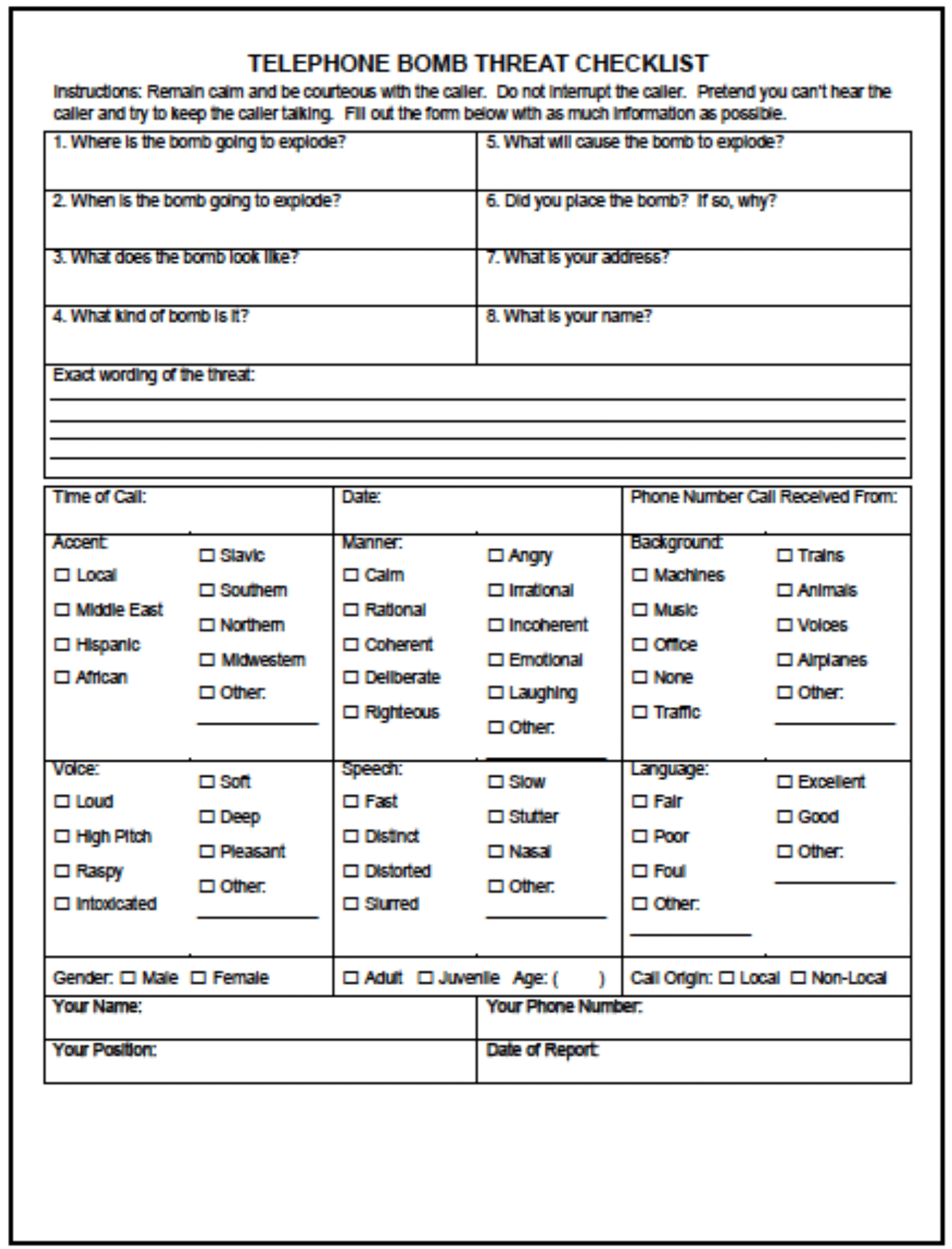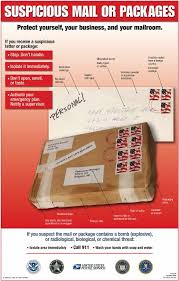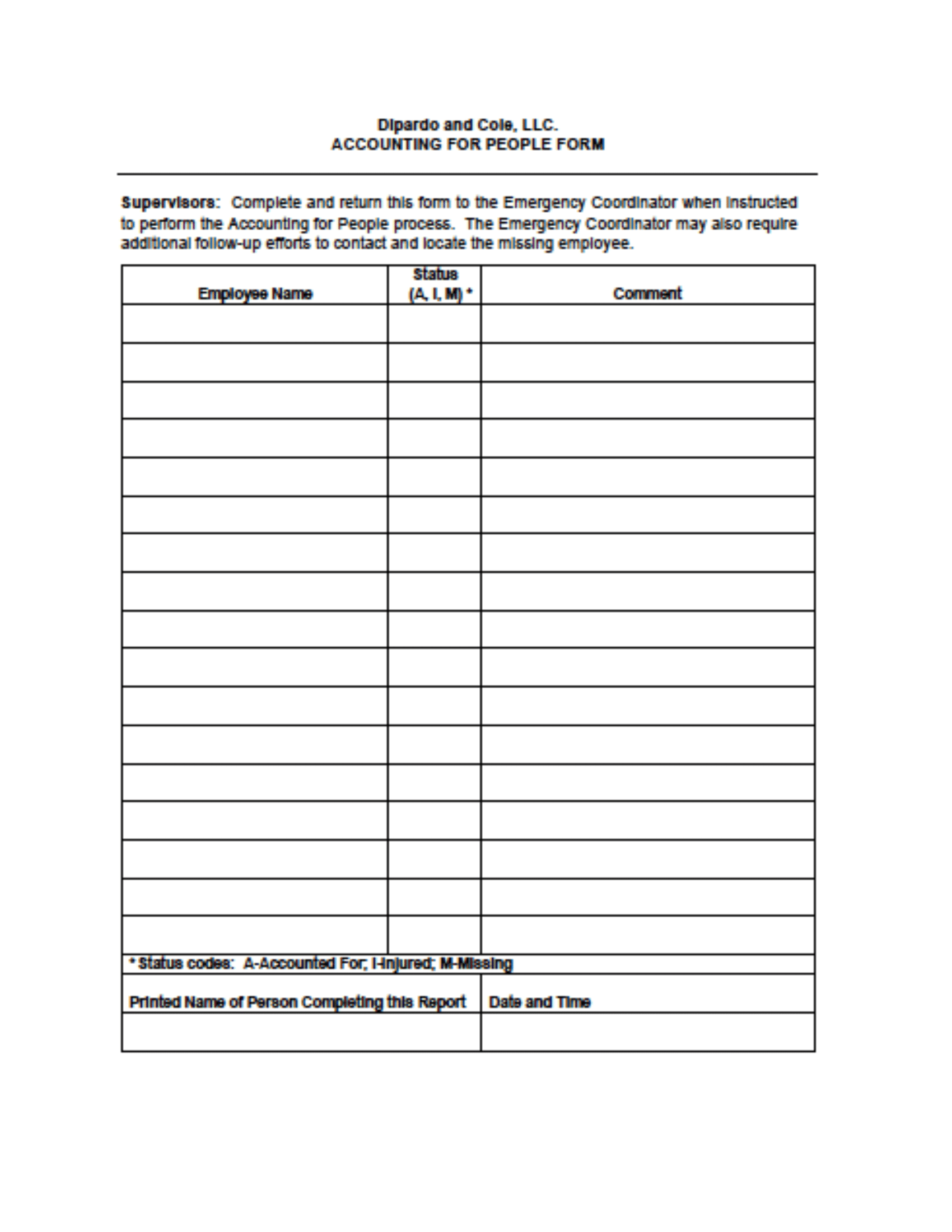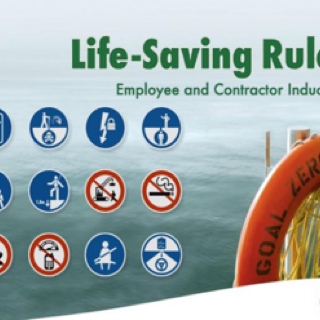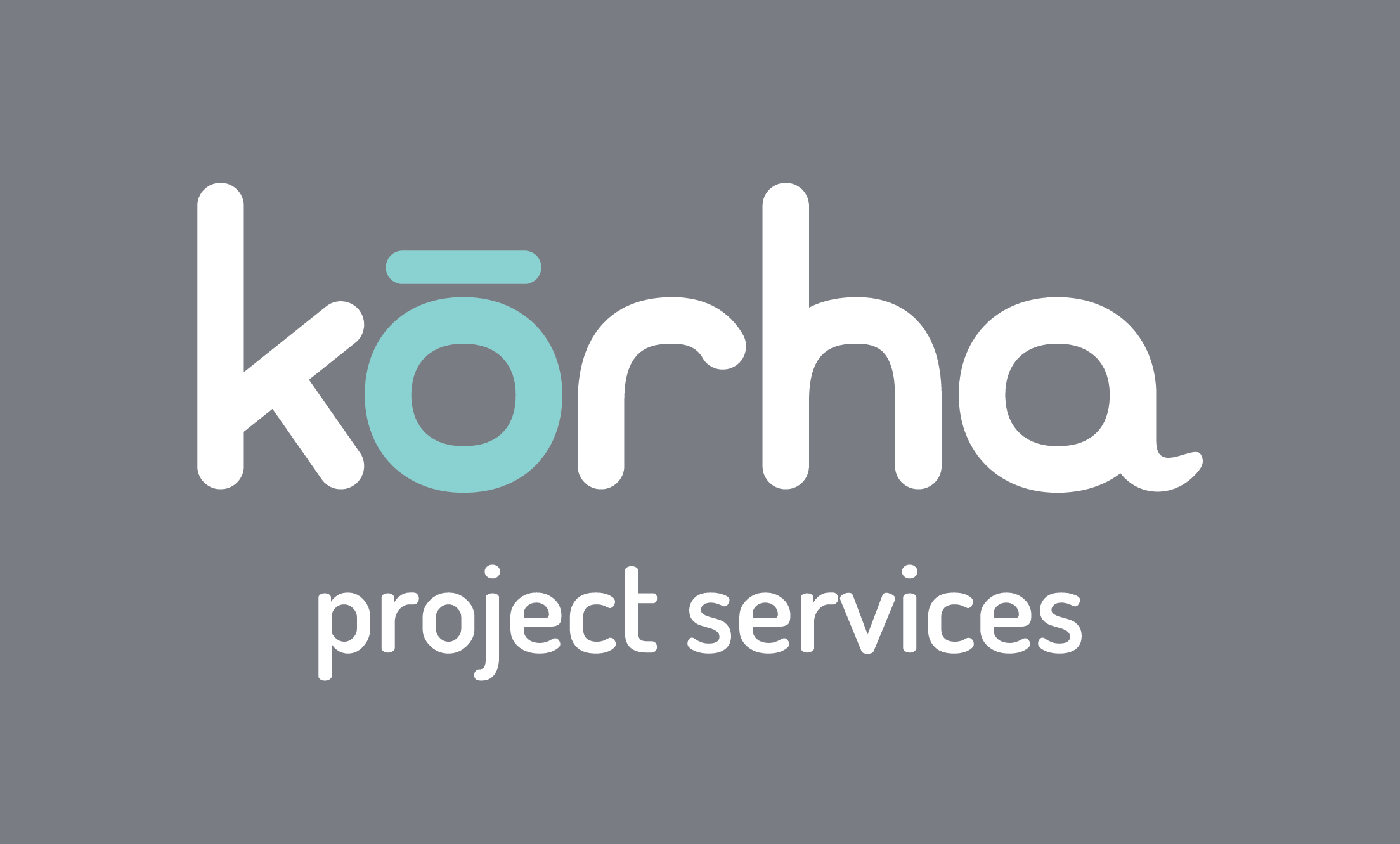Information
-
Audit Title
-
Document No.
-
Prepared by:
-
Prepared on:
-
Emergency Action Plan Location (Drop pin for GPS and street address):
1.1 Purpose:
-
This Emergency Action Plan (EAP or Plan) documents the actions and procedures to be followed by employees in case of emergencies such as fires, severe weather, etc. This EAP has been prepared to meet the requirements of Federal Regulation 29 CFR 1910.38, OSHA Emergency Action Plan Requirements. In addition, the EAP provides specific procedures to be followed in case of certain types of emergencies. However, no emergency plan can anticipate every type of emergency or how any given emergency will begin or progress. Consequently, emergency plans are general guides that should be continuously tested and improved through regular table-top and actual emergency drills.
Each project site and facility appoints a primary Emergency Coordinator. Secondary Emergency Coordinators are also appointed to ensure that at least one Emergency Coordinator is onsite during all operating hours. Any employee who needs more information about the Plan or an explanation of their duties under the Plan can contact the facility Emergency Coordinator or any Safety Professional at: safetyexpert@icloud.com.
1.2 Facility Information and Operations Description:
-
Facility Name:
-
Facility Address:
-
Facility Phone:
1.2.2 Description of Operations:
-
The main purpose of the facility is to provide:
-
Monday through Friday - Hours of Operation:
-
Saturday - Hours of Operation:
-
Sunday - Hours of Operation:
2.1 Alarms:
-
The organization uses an air-horn system to signal emergencies. The main purpose for the notification is to effectively notify personnel and accommodate responding Emergency Services to acquire initial information on an incident prior to entering the project or facility. The alarm system when activating sounds an audible tone in conjunction with visual signaling from work force in high visibility clothing no matter where it was initiated.
The notification system via air horns is further supported by the use of radios and telecommunication devices to facilitate evacuations or coordinate emergency services in siutations noted throughout this plan.
2.2 System Public Address Codes:
-
When using the airhorn to announce such actions required by the employees, the use of codes will aid in assuring overall security. Employee training includes an orientation to these codes.
Air Horn (3) Blasts - Emergency - Shut down equipment and proceed to gathering point
Air Horn (1) Blast - Indicates all clear and employees may return to duty
2.3 Emergency Contact Numbers:
-
In all emergencies, always dial 911 first, in a non-emergency please contact the non-emergency numbers below:
-
Fire Department Phone Number:
-
Police Department Phone Number:
-
Hospital Phone Number:
2.4 Tel-Aid Contacts:
-
Company resource name and phone numbers:
2.5 External Support Contacts:
-
External contract support name and phone numbers:
-
All Emergencies requiring a response under this Plan must be reported to the
office at (540) 693-5978
Responsible Person Signatures:
-
Employee Signature:
Signature
-
Signature - I have reviewed and understand the requirements of the emergency action plan, further I have been provided training on this plan as of today.
3.1 Fire / Explosions:
-
Fire Prevention - Prevention is the best practice for avoiding fire emergencies. All employees will exercise cleanliness in their daily operational area including the machinery utilized to minimize fire risks. Any employee detecting a fire is to immediately activate the nearest fire alarm.
-
Emergency Coordinator-Use the public address system to instruct facility occupants to evacuate the building and proceed to assembly areas. Instruct facility occupants to remain at the assembly areas and participate in the personnel accounting process. Call 911 and follow the instructions of the 911 operator. Instruct facility occupants not to re-enter the facility until after the "All Clear" announcement occurs. Instruct supervisors to conduct the accounting for people process. Instruct supervisors to document and report injuries that have occurred during the incident.
-
Employees - Employees who have been provided with an educational program to familiarize them with the general principles of fire extinguisher use and the hazards involved with incipient stage firefighting may use a fire extinguisher to extinguish a small incipient stage fire prior to exiting the building. All other employees and facility occupants are to evacuate immediately after hearing the fire alarm. All employees and other facility occupants should process. No one should re-enter the facility until after the "all Clear" is communicated.
Participate in the accounting for people process. Return to the facility when the "All Clear" is announced. If the facility is not able to be re-occupied, coordinate with the direct supervisor to resolve transportation, recovery of lost property or other issues. -
Supervisors - Execute the accounting for people process and report results to the Emergency Coordinator. Report the information about injured facility occupants to the Emergency Coordinator. Execute efforts to contact missing employees as instructed by the Emergency Coordinator.
3.2 Hazardous Material Release / Chemical Release
-
3.2-1 - Diesel fuel and oils release - If the alarm sounds:
-
Employees - Immediately evacuate the facility and proceed to an assembly area upwind of the facility. Remain at the assembly area and participate in the accounting for people process. Call 911, to obtain help for injured persons. When the "All Clear" communication occurs, return to the facility.
-
Emergency Coordinator - Use the public address system to advise facility occupants of the situation and to remain at the assembly areas. Instruct employees to participate in the accounting for people process. Call 911 and follow the instructions of the 911 operator. Instruct supervisors to execute the accounting for people process. Contact the Local Emergency response service to the situation. When the public authorities indicate that the area is safe, communicate the "All Clear" announcement.
3.3 Medical Emergency:
-
If any individual is injured or becomes ill requiring medical care, the following steps must be followed:
-
Employees - Call 911 and follow the instructions of the 911 operator. Only trained and qualified employees are authorized to provide first aid. Notify the Emergency Coordinator.
If possible, record the person's name, contact information and the name and contact information of anyone that they need to have notified of the situation.
Until the arrival of responding authorities, keep the person calm and comfortable. Follow the instructions of the responding authorities. After the responding authorities have assessed the person, but before their departure, obtain the name of the destination hospital.
3.4 Security:
-
When an abduction or hostage situation occurs:
-
Employees - Do not attempt to confront, resist or detain the perpetrator. To the extent safely possible, evacuate the facility or hide until law enforcement communicates an "All Clear". As soon as it is safe to do so, call 911. Make mental notes about the description of the perpetrator, the getaway vehicle and the incident. When law enforcement indicates that the scene is safe, Provide law enforcement officers with the details of the incident and your contact information. Provide the Emergency Coordinator with the details of the incident.
3.4-2 Active Shooter:
-
If a violent attack or shooting occurs:
-
Employees - Once outside of the facility, report the location of injured people to law enforcement and the Emergency Coordinator. Remain at the assembly area until the accounting for people process is complete and the "All Clear" has been announced.
Cooperate with law enforcement as requested to support the collection of incident information. Follow instructions from law enforcement, supervisors and/or the Emergency Coordinator on returning to the facility. Advise direct supervisor of the need for transportation, or access to the facility to recover keys or personal items. Advise supervisor of the need for time-off or counseling. -
After the attacker has left the premises, or law enforcement directs evacuation:
-
Employees - If it is safe to do so, call 911 and follow the instructions of the 911 operator.
Evacuate, if possible. Leave your belongings behind. Help others evacuate, but do not attempt to move the wounded. Move quickly to a safe place far from the shooter and take cover. Remain calm and quiet. Keep your hands empty and visible at all times. Follow all instructions from law enforcement. Take shelter/hide, if necessary. Go to the nearest room or office and lock or barricade the doors. Close blinds, turn off lights and cover windows.
Silence all noise. Remain under cover until law enforcement advises that it is safe to evacuate. When law enforcement arrives, Keep hands visible at all times. Remain calm and follow instructions from law enforcement. -
Emergency Coordinator - Instruct supervisors to execute the accounting for people process.
Instruct supervisors to initiate attempts to communicate with missing personnel via phone.
If there are injuries requiring medical attention, call 911 and follow the 911 operator's instructions. -
Supervisors - When instructed, execute the accounting for people process. Report information about incident related injuries to the Emergency Coordinator. Advise the Emergency Coordinator of employee requests for assistance in recovering personal items, transportation home or counseling needs.
3.4-3 Bomb Threat:
-
When a bomb threat call is received:
-
Employees - Use the Bomb Threat Information Form to capture as much information about the call. Call 911 and follow the instructions of the 911 operator. Immediately contact the Emergency Coordinator. When the Emergency Coordinator instructs the evacuation, evacuate the facility and proceed to the assembly area. Remain at the assembly area and participate in the accounting for people process. Do not return to the facility until the "All Clear" is announced.
-
Emergency Coordinator - Immediately, use the public address system to instruct facility occupants to evacuate the facility and proceed to the assembly areas. Instruct supervisors to conduct the accounting for people process at the assembly areas. Call 911 to confirm that the incident was reported. When public authorities indicate that the facility is safe for re-occupancy, Advise public authorities of any missing people. Direct medical responders to the location of anyone injured in the evacuation. Announce the "All Clear" for employees to return to the facility.
-
Telephone Bomb Threat Checklist:
3.4-4 Civil Unrest / Terrorism:
-
If public authorities communicate that a terrorism incident or civil unrest appears imminent or active in the vicinity of the facility:
-
Emergency Coordinator - Use the public address system to advise facility occupants of the situation and to evacuate the facility. If instructed by authorities, close and lockdown the facility. Instruct supervisors to turn on all parking lot lights and turn off all interior lights. When public authorities advise that the situation has passed, instruct supervisors to communicate the "All Clear" to their employees.
-
Employees - Follow instructions to evacuate the facility and proceed to a safe area.
Remain available for communication of the "All Clear" announcement from a supervisor. Monitor the situation through local news resources.
3.4-5 Demonstration / Civil Disturbance:
-
In a situation where a demonstration civil disturbance occurs near the facility:
-
Employees - Do not leave the facility until the Emergency Coordinator or law enforcement indicate that the scene is safe for facility departure. If the Emergency Coordinator announces a shelter-in-place, remain in a safe area and away from windows until the "All
Clear" is announced. Participate in the accounting for people process. -
Emergency Coordinator - Utilize the public address systems to advise facility occupants of the situation and request that all occupants remain in the facility until the situation is deemed safe by law enforcement. Call 911 and follow the instructions of the 911 operator.
When law enforcement indicates that the conditions are safe to leave the facility, Use the public address system to communicate that law enforcement has indicated that conditions are safe to leave the facility. Instruct supervisors to execute the accounting for people process.
3.4-6 Robbery:
-
When a robbery is in progress:
-
Do not attempt to confront, resist or detain the perpetrator. To the extent safely possible, evacuate the facility or hide until law enforcement communicates an "All Clear". As soon as it is safe to do so, call 911. Make mental notes about the description of the robber(s), the getaway vehicle and the incident. When law enforcement indicates that the scene is safe,
Provide law enforcement officers with the details of the incident and your contact information. Provide the Emergency Coordinator with the details of the incident.
3.4-7 Suspicious Package or Substance:
-
If a suspicious package or substance is observed in the area of the facility:
-
Employees - Immediately evacuate the area and advise others to remain out of the area. Do not touch, open or attempt to move the package or spill material. Advise the Emergency Coordinator of the location of the suspicious package or spill. When instructed to evacuate, proceed to the assembly area. Remain at the assembly area until the communication of the "All Clear" announcement. Participate in the accounting for people process. Do not return to the facility until the communication of the "All Clear" announcement.
-
Emergency Coordinator - Call 911 and follow the instructions of the 911 operator. Use the public address system to instruct facility occupants to evacuate the facility and proceed to the assembly area. Instruct employees to remain at the assembly area until the communication of the "All Clear" announcement. Instruct supervisors to execute the accounting for people procedure. When authorities advise that the facility is safe for occupancy, communicate the "All Clear" announcement.
-
U.S.P.S. Suspicious Package Poster:
3.5-1 Earthquake:
-
When shaking occurs within the facility:
-
Employees - If outside, move a safe distance from buildings. If inside, move away from overhead fixtures, windows, and any areas containing shelving that may topple over on you. Take cover under a sturdy piece of furniture or near an interior wall. Drop to the floor and protect your face and head with your hands. Maintain your position until the shaking stops.
When instructed by an Emergency Coordinator, evacuate the facility and proceed to an assembly area. Remain at the assembly area and participate in the accounting for people process. -
Emergency Coordinator - When the shaking has stopped, instruct (public address system, verbally, cell phone and/or text) all employees and other facility occupants to evacuate the building and proceed to the assembly areas. Instruct all employees not to leave the assembly area until released. Instruct supervisors to execute the accounting for people process. Instruct supervisors to locate unaccounted for employees - without re-entering the facility. When public authority arrives, provide a list of person(s) that are unaccounted for and seek assistance in locating these people. When public authority or a structural engineer certifies that the facility is safe to reoccupy, Recommend the restart of operations to the store manager.
3.5-2 Floods:
-
If water rises rapidly in the area of the facility:
-
Emergency Coordinator - Use the public address system to advise facility occupants of the situation and to remain in the facility until the "All Clear" announcement. Instruct supervisors to execute the accounting for people process. When water levels have subsided, communicate the "All Clear" announcement.
-
Employees - Follow instructions to remain in the facility until the communication of the "All Clear" announcement. If outdoors, seek high ground and remain there until the water subsides. Participate in the accounting for people process.
3.5-3 Hurricanes:
-
Weather forecasts for approaching hurricanes and tropical storms allow several days for the orderly shutdown of operations:
-
Employees - Monitor weather reports via local TV and radio stations, smartphone applications and the National Weather Service. Monitor company communications about the impact of the storm on operations. Prepare your personal household for the impact of the storm. Communicate your hurricane plan to your supervisor. Confirm contact information with your supervisor. Participate in the accounting for people process.
-
Emergency Coordinator - Instruct supervisors to update employee contact information.
Update company communication portals. Communicate the date and time of the shutdown of operations. When public authorities indicate that the storm has passed and that travel restrictions are lifted, Instruct supervisors to execute the accounting for people process.
Advise the store manager that conditions are safe to send a damage assessment team the site.
3.5-4 Lightening:
-
When a severe lightning storm approaches the facility:
-
Emergency Coordinator - Use the public address system to advise facility occupants of the situation and to remain in the facility until the "All Clear" announcement. Advise facility occupants to stay away from windows, electrical equipment and large metal objects.
When the storm has passed, communicate the "All Clear" announcement. -
Employees - Follow instructions to remain in the facility until the communication of the "All Clear" announcement. Follow safety instructions.
3.5-5 Tornados:
-
When a tornado is sighted, or sirens or other warnings occur:
-
Emergency Coordinator - Utilize the public address system and other communications tools to advise facility occupants to remain in the facility and take cover. Announce "take cover" instructions: Seek shelter away from windows and outside walls. Seek shelter in shelter-in-place areas, hallways, small interior rooms etc. Use arms to protect head and neck areas. Remain in place until the "All Clear" announcement occurs. When the tornado has passed:
Instruct supervisors to execute the accounting for people process. If people are unaccounted for, instruct supervisors on follow-up process. Instruct employees to report injuries to the Emergency Coordinator. Contact 911 and follow 911 operator instructions.
When first responders arrive, provide the location of injured persons and a list of missing persons. -
Employees - Follow "take cover" instructions. Assist other facility occupants in taking shelter. Remain in a safe place until the "All Clear" is announced. Participate in the accounting for people process.
3.5-6 Winter / Ice Storm:
-
If public authorities announce road closures due to a severe winter storm or ice storm:
-
Emergency Coordinator - Use the public address system to advise facility occupants of the situation and recommend remaining in the facility until travel restrictions are lifted. Instruct supervisors to contact employees scheduled to work to advise them of the situation and to remain at their residence until the travel advisories are lifted. When public authorities lift the travel restrictions, communicate the "All Clear" announcement to facility occupants. Instruct supervisors to contact employee not at the facility to inform them of the end of travel restrictions.
-
Employees - Follow instructions to remain in the facility until the communication of the "All Clear" announcement. If contacted by the supervisor, follow instructions for remaining in place until the communication of the "All Clear" announcement.
3.6-1 Natural Gas Disruption:
-
If a natural gas disruption occurs:
-
Emergency Coordinator - Verbally communicate the instruction for all facility occupants to evacuate the facility and proceed to the assembly area. Instruct facility occupants to remain at the assembly areas until the the communication of the "All Clear" announcement. Instruct supervisors to execute the accounting for people process. If people are unaccounted for, instruct supervisors to contact the missing people. Contact the natural gas utility company. When repairs are complete, communicate the "All Clear" for facility re-occupancy.
-
Employees - When instructed to evacuate, proceed to the assembly area. Remain at the assembly area until the communication of the "All Clear" announcement. Participate in the accounting for people process.
3.6-2 Natural Gas Leak:
-
If a natural gas odor occurs inside the facility:
-
Emergency Coordinator - Verbally communicate the instruction for all facility occupants to evacuate the facility and proceed to the assembly area. Instruct facility occupants to remain at the assembly areas until the the communication of the "All Clear" announcement. Instruct supervisors to execute the accounting for people process. If people are unaccounted for, instruct supervisors to contact the missing people. From a safe distance from the facility, contact the natural gas utility company. When repairs are complete, communicate the "All Clear" for facility re-occupancy.
-
Employees - When instructed to evacuate, proceed to the assembly area. Remain at the assembly area until the communication of the "All Clear" announcement. Participate in the accounting for people process.
3.6-3 Power Disruption:
-
If a power outage occurs for an extended period:
-
Emergency Coordinator - Verbally communicate the instruction for all facility occupants to evacuate the facility and proceed to the assembly area. Instruct facility occupants to remain at the assembly areas until the the communication of the "All Clear" announcement. Instruct supervisors to execute the accounting for people process. If people are unaccounted for, instruct supervisors to contact the missing people. Contact the power utility company.
When repairs are complete, communicate the "All Clear" for facility re-occupancy. -
Employees - When instructed to evacuate, proceed to the assembly area. Remain at the assembly area until the communication of the "All Clear" announcement. Participate in the accounting for people process.
3.6-4 Water Service Disruption:
-
If low water pressure or no water pressure is detected at the facility:
-
Employees - Report water disruption to the Emergency Coordinator. When instructed, proceed to the assembly area and participate in the accounting for people process. Remain at the assembly area until released by a supervisor.
-
Emergency Coordinator - Use the public address system to instruct facility occupants to evacuate the facility and proceed to the assembly area. Contact the water utility company.
Instruct supervisors to contact missing persons. When repairs are complete, communicate the "All Clear" to re-occupy the facility.
4.1 Accounting for People:
-
Certain emergencies, such as a fire, may require the execution of the Accounting for People process to affirm the location and safety of employees. The decision to execute the Accounting for People process, will be made by the acting Emergency Coordinator. Communication of the activation of the Accounting for People process will occur through the Building / Facility intercom system, or verbally if there is no intercom system. All employees are required to participate in the Accounting for People process. Supervisors shall determine missing employees as soon as the process can safely occur. Supervisors will advise the Emergency Coordinator of missing or injured employees as quickly as possible. Supervisors are advised to use the Accounting for People Form (Figure 4.1-1) to assist in the identification of missing employees. The Emergency Coordinator will report missing employees to responding authorities. The Emergency Coordinator will determine the method to be utilized to locate missing personnel, including attempting to call or text the individual.
-
4.1-1 Accounting for People Form
4.2 Isolation Procedures:
-
When a Fire has been located and has gone beyond the initial incipient stage, the initial actions of the employee(s) will be to activate the fire alarm system and isolate an immediate area of the fire's origin by closing doors limiting the travel of the fire and the flow path of the smoke. This initial action will allow the existing Fire sprinkler suppression system to control if not extinguish the fire while waiting for the arrival of the Fire Department.
-
Other hazards that may occur will require the same initial actions by the employee(s) with an additional consideration of utilizing the available ventilation system in the concerned area. In certain incidents exhausting the air in the affected area may remove and or lessen the hazard. This decision will be made by the Manager on Duty.
-
In either case, life safety is the priority. When considering the isolation of an area(s) by closing doors, Do Not Lock the doors impeding egress from any area.
4.3 Evacuation Procedures:
-
Certain emergencies, such as a fire alarm or bomb threat, may require employees to evacuate the facility.
-
The decision to shelter in place will be made by the acting Emergency Coordinator.
-
Notification of a shelter in place will occur through the Building / Facility intercom system, or verbally if there is no intercom system, which will provide specific instructions to employees and other facility occupants.
-
All employees must remain at the Assembly Area until the Emergency Coordinator gives the all-clear that it is safe to return to the facility.
-
If instructed by the Emergency Coordinator, all employees will participate in the Accounting for People process.
-
4.3-1 Evacuation and Assembly Area Map - Photo of Gathering Area (Attached):
4.4 Shelter In Place Procedures:
-
Certain emergencies, such as severe weather, may require employees to take shelter within the facility. The decision to shelter in place will be made by the acting Emergency Coordinator. Notification of a shelter in place will occur through the Building / Facility intercom system, or verbally if there is no intercom system, which will provide specific instructions to employees and other facility occupants. Upon receiving the instruction to seek shelter, all employees must proceed to the nearest shelter location as indicated in
emergency maps posted throughout the building and in Figure 4.4-1. All employees must remain at the Shelter Area until the Emergency Coordinator gives the all-clear that it is safe to exit the Shelter Area. If instructed by the Emergency Coordinator, all employees will participate in the Accounting for People process. -
The decision to shelter in place will be made by the acting Emergency Coordinator. Notification of a shelter in place will occur through the Project Site / Facility, or verbally if there is no intercom system, which will provide specific instructions to employees and other project or facility occupants. Upon receiving the instruction to seek shelter, all employees must proceed to the nearest shelter location as indicated in emergency maps posted throughout the building and contained in the rear of this handbook. All supervisors shall account for their direct reports at the designated Shelter Areas. The names and information regarding any employees that cannot be accounted for shall immediately be reported to the Emergency Coordinator. The Emergency Coordinator will determine the method to be utilized to locate missing personnel, including attempting to call or text the individual. The Emergency Coordinator will advise any responding authorities of any missing personnel.
A.1 Emergency Equipment:
-
The organization maintains an active inventory of a variety of emergency equipment including, but not limited to: portable fire extinguishers, spill kits/equipment, first aid kits, and eye wash kits. Available emergency equipment is maintained in accordance with applicable regulatory requirements and associated manufacturer specifications. Monthly inspections are completed for the emergency equipment to verify that it is adequately maintained and to meet additional regulatory requirements.
A.2 Fire Prevention and Control Equipment:
-
The following equipment will be inspected and documented by Facilities Management and its contracted services to assure all systems are fully operational. The wet fire sprinkler system covers the entire facility and is supplied by various control valves designated by designed zones. If at any time a system needs to be put out of service for more than 4 hours, a Fire Watch [OSHA 1910.6(q)(25)] would be required to continue occupancy. The Standpipe system (type I / for Fire Department use only) is located per code by exterior doors for the use by the Fire Department.
A.3 Hazardous Storage Area:
-
Please refer to the SDS respository via mobile application or printed copy. This is found in the hazardous chemical inventory.
A.4 Major Hazards:
-
Hazards listed here:
A.5 Training:
-
Each employee will be trained on the contents of this Plan: Initially when the plan is developed. Whenever a new employee is hired. Whenever an employee's responsibilities or designated actions under the plan change. Whenever new equipment, materials, or processes are introduced into the workplace which affect the emergency action process. Whenever the layout or design or the facility changes and whenever the plan is changed.
Whenever the layout or design or the facility changes and whenever the plan is changed.
The Emergency Coordinator will lead two emergency drills per year. One of these drills shall be of the Evacuation Procedure. After each drill, the Primary Emergency Coordinator will judge the effectiveness of the EAP, review any employee input concerning the drill, and update the EAP as required.






